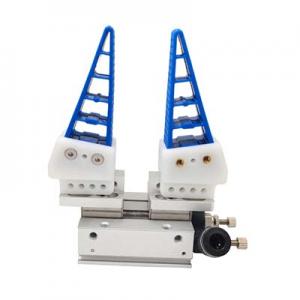No-code Robot
A no-code drag-and-drop teaching robot arm for spraying systems is a robotic arm designed specifically for automated spraying applications (like painting, coating, or applying adhesives) that can be programmed through an intuitive, visual interface. Instead of requiring complex coding, operators can teach the robot the desired spraying motions and parameters by physically guiding the arm and using a drag-and-drop software environment.

Key Features:
No-Code Programming: The primary characteristic is the elimination of traditional programming languages. Users interact with a graphical interface, often involving dragging and dropping pre-built function blocks or icons to define the robot's actions.
Drag-and-Drop Teaching: Operators can physically move the robot arm through the required spraying path. Sensors on the arm record these movements, which the software then translates into a robotic program. Some systems might use a handheld teaching handle for more ergonomic guidance.
Intuitive User Interface: The software is designed to be user-friendly, requiring minimal training. It often includes features like 3D visualization of the robot's workspace and the programmed path.
Spraying Functionality: The robot arm is equipped or designed to integrate with spraying equipment, such as paint guns, nozzles, and material supply systems.
Path Editing and Optimization: The software usually allows users to refine the recorded path, adjust speed, flow rate, spray angles, and other parameters through the graphical interface.
Integration with Sensors and Vision Systems: Some advanced systems may incorporate sensors or vision systems to adapt the spraying based on the workpiece's shape, orientation, or surface characteristics.
Safety Features: Depending on the application, these robots may include safety features like collision detection to protect operators and equipment.
Benefits for Spraying Systems:
Ease of Use: Significantly reduces the complexity and time associated with traditional robot programming, making automation accessible to a wider range of users without specialized robotics expertise.
Faster Programming and Setup: Teaching the robot through physical demonstration is often much quicker than writing code, leading to reduced setup times and faster deployment.
Flexibility and Adaptability: Easy reprogramming allows for quick adjustments when dealing with different part types, sizes, or spraying requirements, making it ideal for small-batch production or high-mix environments.
Improved Consistency and Quality: Robots ensure consistent and repeatable spraying patterns, leading to higher quality finishes and reduced material waste compared to manual spraying.
Transfer of Expertise: Skilled painters can easily transfer their techniques and know-how to the robot through the intuitive teaching process, ensuring the robot replicates expert movements.
Enhanced Safety: Automating spraying tasks can protect human workers from hazardous materials and environments.
Increased Productivity: Robots can work continuously and consistently, leading to higher throughput and reduced cycle times.
Cost Reduction: Automation can lower labor costs, reduce material waste, and improve overall efficiency.
Applications in Spraying Systems:
No-code drag-and-drop teaching robot arms are suitable for a wide range of spraying applications, including:
Painting: Applying paint to various products, from automotive parts and furniture to appliances and electronics.
Coating: Applying protective or functional coatings, such as powder coating, lacquering, and varnishing.
Adhesive Application: Applying precise amounts of adhesives in manufacturing and assembly processes.
Sealing and Gasketing: Automating the application of sealants and gaskets.
Thermal Spraying: Applying metallic or ceramic coatings for wear resistance, corrosion protection, or thermal barriers.
Blasting and Peening: In some cases, the "spraying" concept can be extended to abrasive blasting or peening processes for surface treatment.
In summary, no-code drag-and-drop teaching robot arms offer a user-friendly and efficient way to automate spraying processes, providing benefits in terms of ease of use, flexibility, quality, and productivity. They democratize robot programming, making it accessible to operators without extensive coding knowledge.








